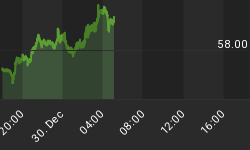The price of gold has performed impressively since August in line with the positive seasonal bias of the year. But one factor that may be influencing gold's rally is the peaking of the Kress 6-year cycle this year. Although primarily an equities market cycle, the 6-year cycle does tend to exert an influence on gold due to its inflation-sensitive nature and indirect correlation to stock market and economic trends.
Take a look at the long-term monthly chart of gold futures below. Note the squared off areas in the years 1987, 1993 and 1999. What do these three years all have in common? They were all 6-year cycle peak years. The 6-year cycle peaked in the fourth quarter of 1987, in the middle part of 1993 and in the later part of 1999. The gold price spiked at or very near the peaking process of the 6-year in all three years. This was undoubtedly attributable, in part, to the "fear factor" associated with cycle peaks and the subsequent downturn in equities prices as investors seek out financial safe havens in such times. And as we all know, gold is one of the first safe havens that comes immediately to mind in turbulent financial conditions.

The yearly cycles in the Kress 120-year cycle schema are unique in that the peaks can, to some degree, be "stretched out" by gamesmanship on the part of the financial regulators. A 6-year cycle peak can, for instance, be pushed out a few months longer than normal before turning down through the many instruments the Fed and its allies have to work with. These obviously include the interest rate, the monetary aggregates, securities lending, etc. Right now it's obviously the 6-year cycle is in the peaking process, but there's no way of knowing with certainty when it will finish peaking until after the fact. But even after the 6-year cycle finishes peaking, the effects in the gold market are belated since even after the cycle turns down and the effects are seen in the more sensitive parts of the financial market, gold usually gets the benefit of a post-cycle peak rally as money flows from stocks and other areas into the yellow metal - hence, the post-crash rally in gold in 1987.
Another interesting aspect of the year 1987 (seen in the long-term gold chart above) with respect to the 6-year cycle peak is that gold around that time hit resistance beginning at $500 and slightly higher before turning down. The price of gold is now getting close to that juncture, with analysts talking once again in terms of $500 gold. Despite the length of time that has transpired from 1987 until now the psychological resistance is still a factor and it will be interesting to see how gold reacts upon nearing this pivotal area. In my view, the longer the 6-year cycle is pushed out, the better it bodes for gold overcoming $500 before the end of the year.
Despite their pronouncements to the contrary, the Fed has been working to keep the inflationary trend going with its stubborn persistence in raising the fed funds rate. The effects of this important rate over an extended period produces significant upward pressure on the overall domestic price level, as noted by economist George Brockway. In his book, "The End of Economic Man" he observes "the empirical record does not support the theory that a high interest rate controls inflation..." Quite the contrary. He quotes the Federal Reserve Board of Cleveland in a 1995 bulletin as stating, "One of the strongest correlations in economics is the positive relationship between inflation and the fed funds rate...Thus we are left to contend with the paradox that ultimately lower inflation must be associated with lower, not higher, interest rates."

As an aside, notice also the MZM chart, above, showing an interesting correlation with the price of gold since last year. A steadfast refusal on the Fed's part to stop raising rates ultimately bodes well for inflation-sensitive commodities. When this happens in a 6-year cycle peak year it only intensifies the effect.
















